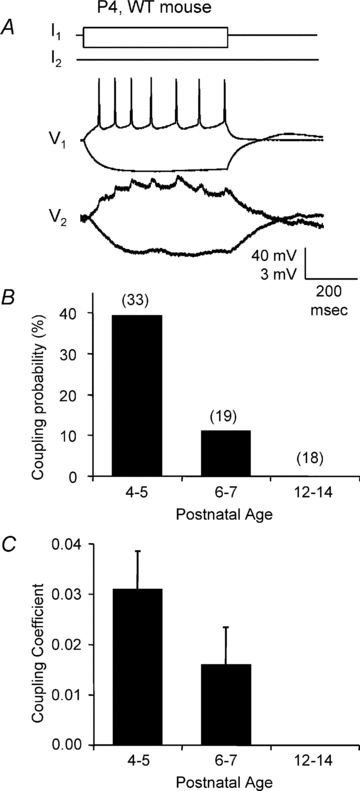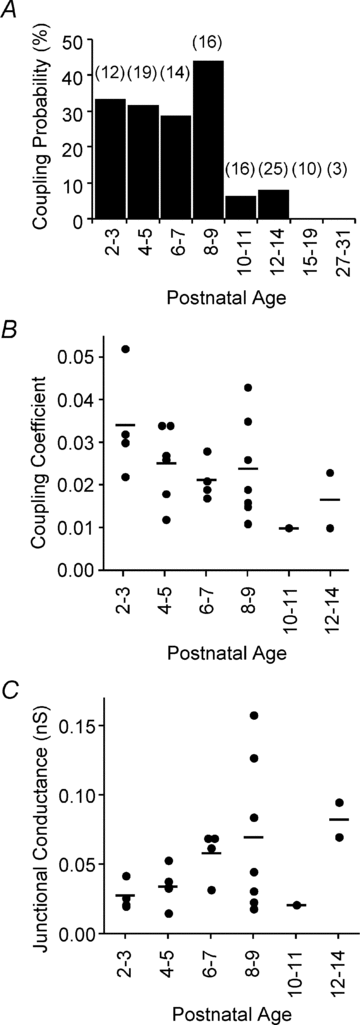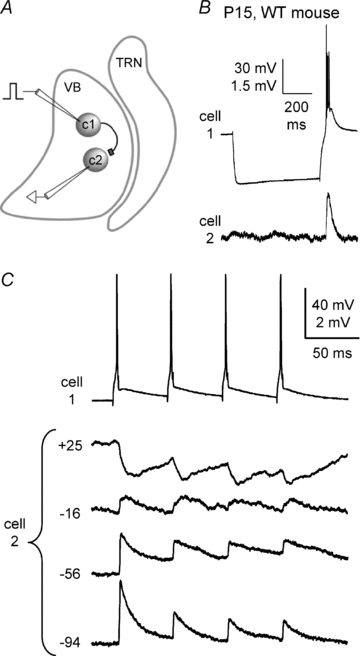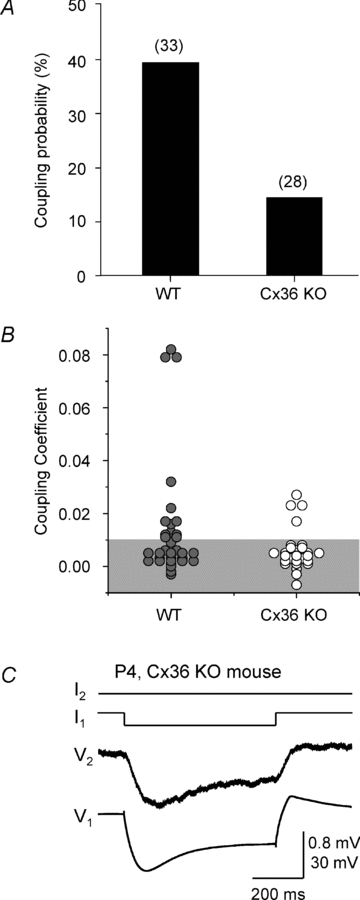Electrical and chemical synapses between relay neurons in developing thalamus
- PMID: 20457735
- PMCID: PMC2915516
- DOI: 10.1113/jphysiol.2010.187096
Electrical and chemical synapses between relay neurons in developing thalamus
Abstract
Gap junction-mediated electrical synapses interconnect diverse types of neurons in the mammalian brain, and they may play important roles in the synchronization and development of neural circuits. Thalamic relay neurons are the major source of input to neocortex. Electrical synapses have not been directly observed between relay neurons in either developing or adult animals. We tested for electrical synapses by recording from pairs of relay neurons in acute slices of developing ventrobasal nucleus (VBN) of the thalamus from rats and mice. Electrical synapses were common between VBN relay neurons during the first postnatal week, and then declined sharply during the second week. Electrical coupling was reduced among cells of connexin36 (Cx36) knockout mice; however, some neuron pairs remained coupled. This implies that electrical synapses between the majority of coupled VBN neurons require Cx36 but that other gap junction proteins also contribute. The anatomical distribution of a beta-galactosidase reporter indicated that Cx36 was expressed in some VBN neurons during the first postnatal week and sharply declined over the second week, consistent with our physiological results. VBN relay neurons also communicated via chemical synapses. Rare pairs of relay neurons excited one another monosynaptically. Much more commonly, spikes in one relay neuron evoked disynaptic inhibition (via the thalamic reticular nucleus) in the same or a neighbouring relay neuron. Disynaptic inhibition between VBN cells emerged as electrical coupling was decreasing, during the second postnatal week. Our results demonstrate that thalamic relay neurons communicate primarily via electrical synapses during early postnatal development, and then lose their electrical coupling as a chemical synapse-mediated inhibitory circuit matures.
Figures







Similar articles
-
Electrical synapses and the development of inhibitory circuits in the thalamus.J Physiol. 2016 May 15;594(10):2579-92. doi: 10.1113/JP271880. Epub 2016 Mar 23. J Physiol. 2016. PMID: 26864476 Free PMC article.
-
Synchronous activity of inhibitory networks in neocortex requires electrical synapses containing connexin36.Neuron. 2001 Aug 16;31(3):477-85. doi: 10.1016/s0896-6273(01)00373-7. Neuron. 2001. PMID: 11516403
-
Stability of electrical coupling despite massive developmental changes of intrinsic neuronal physiology.J Neurosci. 2009 Aug 5;29(31):9761-70. doi: 10.1523/JNEUROSCI.4568-08.2009. J Neurosci. 2009. PMID: 19657029 Free PMC article.
-
Electrical synapses in the mammalian brain.Annu Rev Neurosci. 2004;27:393-418. doi: 10.1146/annurev.neuro.26.041002.131128. Annu Rev Neurosci. 2004. PMID: 15217338 Review.
-
Connexon connexions in the thalamocortical system.Prog Brain Res. 2005;149:41-57. doi: 10.1016/S0079-6123(05)49004-4. Prog Brain Res. 2005. PMID: 16226575 Review.
Cited by
-
Neuronal gap junctions: making and breaking connections during development and injury.Trends Neurosci. 2013 Apr;36(4):227-36. doi: 10.1016/j.tins.2012.11.001. Epub 2012 Dec 11. Trends Neurosci. 2013. PMID: 23237660 Free PMC article. Review.
-
Postnatal development of synaptic properties of the GABAergic projection from the inferior colliculus to the auditory thalamus.J Neurophysiol. 2013 Jun;109(12):2866-82. doi: 10.1152/jn.00021.2013. Epub 2013 Mar 27. J Neurophysiol. 2013. PMID: 23536710 Free PMC article.
-
Differential Excitation of Distally versus Proximally Targeting Cortical Interneurons by Unitary Thalamocortical Bursts.J Neurosci. 2016 Jun 29;36(26):6906-16. doi: 10.1523/JNEUROSCI.0739-16.2016. J Neurosci. 2016. PMID: 27358449 Free PMC article.
-
Analysis of the role of the low threshold currents IT and Ih in intrinsic delta oscillations of thalamocortical neurons.Front Comput Neurosci. 2015 May 7;9:52. doi: 10.3389/fncom.2015.00052. eCollection 2015. Front Comput Neurosci. 2015. PMID: 25999847 Free PMC article.
-
Electrical synapses and the development of inhibitory circuits in the thalamus.J Physiol. 2016 May 15;594(10):2579-92. doi: 10.1113/JP271880. Epub 2016 Mar 23. J Physiol. 2016. PMID: 26864476 Free PMC article.
References
-
- Agmon A, Connors BW. Thalamocortical responses of mouse somatosensory (barrel) cortex in vitro. Neuroscience. 1991;41:365–379. - PubMed
-
- Arumugam H, Liu X, Colombo PJ, Corriveau RA, Belousov AB. NMDA receptors regulate developmental gap junction uncoupling via CREB signalling. Nat Neurosci. 2005;8:1720–1726. - PubMed
-
- Belluardo N, Mudo G, Trovato-Salinaro A, Le Gurun S, Charollais A, Serre-Beinier V, Amato G, Haefliger JA, Meda P, Condorelli DF. Expression of connexin36 in the adult and developing rat brain. Brain Res. 2000;865:121–138. - PubMed
-
- Bennett MV. Physiology of electrotonic junctions. Ann N Y Acad Sci. 1966;137:509–539. - PubMed
Publication types
MeSH terms
Substances
Grants and funding
LinkOut - more resources
Full Text Sources
Molecular Biology Databases
Miscellaneous

